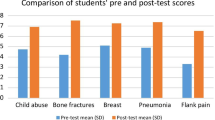Background
Effective learning can occur at the point of care, when opportunities arise to acquire information and apply it to a clinical problem. To assess interest in point-of-care learning, we conducted a survey to explore radiologists' attitudes and preferences regarding the use of just-in-time learning (JITL) in radiology.
Materials and Methods
Following Institutional Review Board approval, we invited 104 current radiology residents and 86 radiologists in practice to participate in a 12-item Internet-based survey to assess their attitudes toward just-in-time learning. Voluntary participation in the survey was solicited by e-mail; respondents completed the survey on a web-based form.
Results
Seventy-nine physicians completed the questionnaire, including 47 radiology residents and 32 radiologists in practice; the overall response rate was 42%. Respondents generally expressed a strong interest for JITL: 96% indicated a willingness to try such a system, and 38% indicated that they definitely would use a JITL system. They expressed apreference for learning interventions of 5–10 min in length.
Conclusions
Current and recent radiology trainees have expressed a strong interest in just-in-time learning. The information from this survey should be useful in pursuing the design of learning interventions and systems for delivering just-in-time learning to radiologists.
Similar content being viewed by others
References
RD Fox PE Mazmanian RW Putnam (Eds) (1989) Changing and Learning in the Lives of Physicians Praeger New York
AC Greiner E Knebel (Eds) (2002) Health Professions Education: A Bridge to Quality National Academies Press Washington, DC
DA Davis MA Thomson AD Oxman RB Haynes (1995) ArticleTitleChanging physician performance. A systematic review of the effect of continuing medical education strategies JAMA 274 700–705 Occurrence Handle7650822 Occurrence Handle1:STN:280:ByqA2sbhs1A%3D Occurrence Handle10.1001/jama.274.9.700
MR Patel TJ Meine J Radeva et al. (2004) ArticleTitleState-mandated continuing medical education and the use of proven therapies in patients with an acute myocardial infarction J Am Coll Cardiol 44 192–198 Occurrence Handle15234433 Occurrence Handle10.1016/j.jacc.2004.03.070
JS Brown A Collins P Duguid (1989) ArticleTitleSituated cognition and the culture of learning Educ Res 18 32–42
J Lave E Wenger (1990) Situated Learning: Legitimate Peripheral Participation Cambridge University Press Cambridge
MS Knowles (1980) The Modern Practice of Adult Education: From Pedagogy to Andragogy Cambridge, The Adult Education Company New York
R Wutoh SA Boren EA Balas (2004) ArticleTitleeLearning: A review of Internet-based continuing medical education J Contin Educ Health Prof 24 20–30 Occurrence Handle15069909 Occurrence Handle10.1002/chp.1340240105
L Casebeer RE Kristofco S Strasser et al. (2004) ArticleTitleStandardizing evaluation of on-line continuing medical education: Physician knowledge, attitudes, and reflection on practice J Contin Educ Health Prof 24 68–75 Occurrence Handle15279131 Occurrence Handle10.1002/chp.1340240203
DM Kaufman (2003) ArticleTitleApplying educational theory in practice BMJ 326 213–216 Occurrence Handle12543841 Occurrence Handle10.1136/bmj.326.7382.213
RM Harden (2005) ArticleTitleA new vision for distance learning and continuing medical education J Contin Educ Health Prof 25 43–51 Occurrence Handle16078802 Occurrence Handle10.1002/chp.8
American Medical Association (2005) Internet Point ofCare. American Medical Association.<http://www.ama-assn.org/ama/pub/category/15085.html>. Accessed 7 June 2005
RB Elson JG Faughnan DP Connelly (1997) ArticleTitleAn industrial process view of information delivery to support clinical decision making: Implications for systems design and process measures J Am Med Inform Assoc 4 266–278 Occurrence Handle9223033 Occurrence Handle1:STN:280:ByiA28nit1c%3D
MK Robertson KE Umble RM Cervero (2003) ArticleTitleImpact studies in continuing education for health professions: Update J Contin Educ Health Prof 23 146–156 Occurrence Handle14528785 Occurrence Handle10.1002/chp.1340230305
InstitutionalAuthorNameEvidence-Based Radiology Working Group (2001) ArticleTitleEvidence-based radiology: A new approach to the practice of radiology Radiology 220 566–575
JE Madewell RR Hattery SR Thomas et al. (2005) ArticleTitleMaintenance of Certification Am J Roentgenol 184 3–10
TKL Schleyer JL Forrest (2000) ArticleTitleMethods for the design and administration of web-based surveys J Am Med Inform Assoc 7 416–425 Occurrence Handle10887169 Occurrence Handle1:STN:280:DC%2BD3czpt1KmtA%3D%3D
JC Wyatt (2000) ArticleTitleWhen to use web-based surveys J Am Med Inform Assoc 7 426–429 Occurrence Handle10887170 Occurrence Handle1:STN:280:DC%2BD3czpt1KmtQ%3D%3D
AE Flanders JA Carrino (2003) ArticleTitleUnderstanding DICOM and IHE Semin Roentgenol 38 270–281 Occurrence Handle14513730 Occurrence Handle10.1016/S0037-198X(03)00044-0
CD Carr SM Moore (2003) ArticleTitleIHE: A model for driving adoption of standards Comput Med Imaging Graph 27 137–146 Occurrence Handle12620304 Occurrence Handle10.1016/S0895-6111(02)00087-3
Acknowledgments
This study was supported in part by a research grant to C.E.K. from the Society for Computer Applications in Radiology (SCAR). The authors are grateful to the radiologists who participated in the survey. We thank Ms. Susan Liberski for her assistance in preparing and conducting the survey, and Dr. Paul Nagy for critical review of the manuscript.
Author information
Authors and Affiliations
Corresponding author
Rights and permissions
About this article
Cite this article
Kahn, C.E., Ehlers, K.C. & Wood, B.P. Radiologists' Preferences for Just-in-Time Learning. J Digit Imaging 19, 202–206 (2006). https://doi.org/10.1007/s10278-005-9242-y
Published:
Issue Date:
DOI: https://doi.org/10.1007/s10278-005-9242-y




